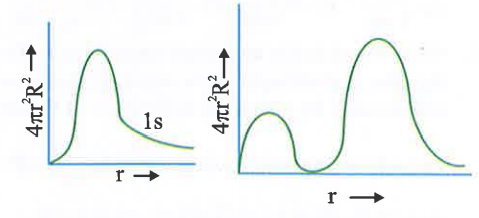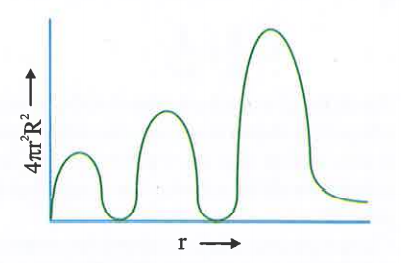The wave function for an orbital is H-atom is given as
ψ=(√281√π)(1a0)32(6−ra0)(ra0)er3a0.sinθsinϕ
The orbital is :
2s
3p
2p
3d
The correct Answer is:A, B
Topper's Solved these Questions
Similar Questions
a.The schrodinger wave equation for hydrogen atom is ψ2s=14√2π(1a0)32(2−r0a0)e(−ra)
When a0 is Bohr's radius Let the radial node in 2s be n at Then find r0 in terms of a0
b. A base ball having mass 100g moves with velocity 100ms−1.Find the value of teh wavelength of teh base ball
View SolutionThe wave function of 2s electron is given by
ψ2s=14√2π(1a0)3/2(2−ra0)e−ra0
It has a node at r=rp . Find the relation between rp and a.
View Solution
Knowledge Check
For the wave function
Ψ=√281√πa3/20[6−ra0]ra0×e−r/3a0sinθ.cosϕ
Identify the orbital .A3pxB3pyC3pzD6pxor6pyor6pzGiven R(r)=19√3(14π)1/2(1a0)3/2(6−4ra0+49r2a20)e.r3a0
Which in INCORRECT statement about R(r ).AThe number of angular nodes is zero.BThe number of radii nodes is 2.CThe distance between radial nodes is √27a0.DThe equation represents 2s orbitalThe Schrodinger wave equation for H-atom is
∇2Ψ=8π2mh2(E−V)Ψ=0
Where ∇2=∂2∂x2+∂2∂y2+∂2∂z2
E = Total energy and V=potential energy wave function Ψ(rθϕ)R(r)Θ(θ)Φ(ϕ)
R is radial wave function which is function of ''r'' only, where r is the distance from nucleus. Θ and Φ are angular wave function. R2 is known as radial probability density and 4πr2R2dr is known as radial probability function i.e., the probability of finding the electron is spherical shell of thickness dr.
Number of radial node =n -l - 1
Number of angular node = l
For hydrogen atom, wave function for 1s and 2s-orbitals are:
Ψ1s=√1πaa0e−zr/a0
Ψ2s=(Z2a0)½(1−Zra0)e−Zra0
The plot of radial probability function 4πr2R2 aganist r will be:

Answer the following questions:
The following graph is plotted for ns-orbitals

The value of 'n' will be:A1B2C3D4
(a) The wave function of an electron in 2s orbital in hydrogen atom is given below:
ψ2s=14(2π)1/2(za0)3/2(2−ra0)exp(−r/2a0)
where a0 is the radius. This wave function has a radial node at r=r0. Express r0 in terms of a0.
(b) Calculate the wavelength of a ball of mass 100g moving with a velocity of 100ms−1.
View Solution(a) The wave function of an electron in 2s orbital in hydrogen atom is given below:
ψ2s=14(2π)1/2(za0)3/2(2−ra0)exp(−r/2a0)
where a0 is the radius. This wave function has a radial node at r=r0. Express r0 in terms of a0.
(b) Calculate the wavelength of a ball of mass 100g moving with a velocity of 100ms−1.
(c) _(92)X.238−8α−−−−−→−6βY. Find out atomic number, mass number of Y and identify it.
View SolutionThe wave function of 3s electron is given by
Ψ3s=181√3∏(1a0)3/2[27−18(ra0)+2(ra0)2]e−r/3a0
It has a node at r=r0, Find out the relation between r0 and a0
View SolutionThe wave function of 3s electron is given by
Ψ3s=181√3∏(1a0)3/2[27−18(ra0)+2(ra0)2]e−r/3a0
It has a node at r=r0, Find out the relation between r0 and a0
View Solution[" The Schrodinger wave equation "],[" for hydrogen atom is: "],[qquad [psi_(2s)=(1)/(4sqrt(2 pi))((1)/(a_(0)))^(3/2)(2-(r_(0))/(a_(0)))e^((-r_(0))/(a_(0))),],[" where "a_(0)" is Bohr's radius.If the "],[" radial node is "2s" be at "r_(0)," then the "],[" value of "(r_(0))/(a_(0))" is "]]
View Solution
